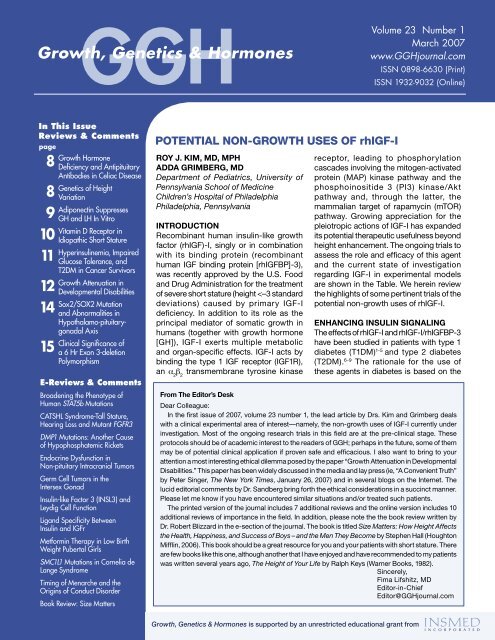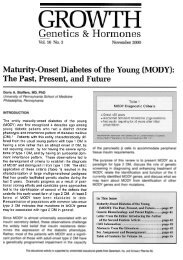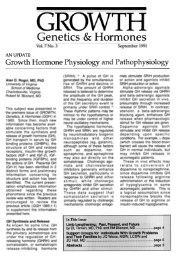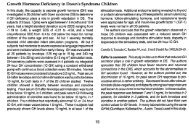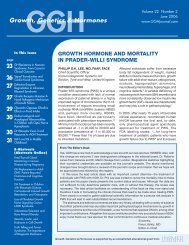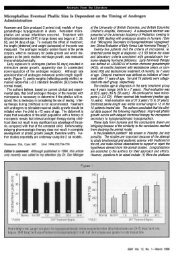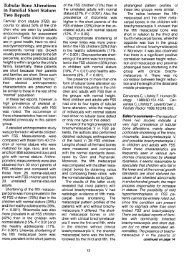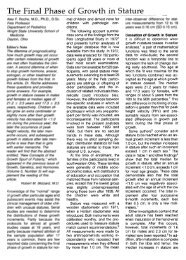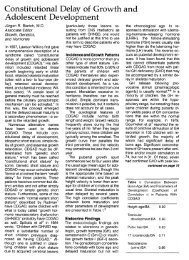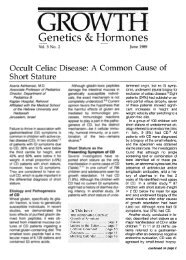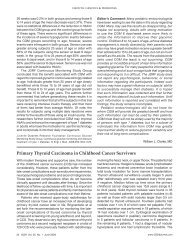Print version (PDF) - GGH Journal
Print version (PDF) - GGH Journal
Print version (PDF) - GGH Journal
Create successful ePaper yourself
Turn your PDF publications into a flip-book with our unique Google optimized e-Paper software.
<strong>GGH</strong><br />
Growth, Genetics & Hormones<br />
Volume 23 Number 1<br />
March 2007<br />
www.<strong>GGH</strong>journal.com<br />
ISSN 0898-6630 (<strong>Print</strong>)<br />
ISSN 1932-9032 (Online)<br />
In This Issue<br />
Reviews & Comments<br />
page<br />
8<br />
8<br />
9<br />
10<br />
11<br />
12<br />
14<br />
15<br />
Growth Hormone<br />
Deficiency and Antipituitary<br />
Antibodies in Celiac Disease<br />
Genetics of Height<br />
Variation<br />
Adiponectin Suppresses<br />
GH and LH In Vitro<br />
Vitamin D Receptor in<br />
Idiopathic Short Stature<br />
Hyperinsulinemia, Impaired<br />
Glucose Tolerance, and<br />
T2DM in Cancer Survivors<br />
Growth Attenuation in<br />
Developmental Disabilities<br />
Sox2/SOX2 Mutation<br />
and Abnormalities in<br />
Hypothalamo-pituitarygonadal<br />
Axis<br />
Clinical Significance of<br />
a 6 Hr Exon 3-deletion<br />
Polymorphism<br />
E-Reviews & Comments<br />
Broadening the Phenotype of<br />
Human STAT5b Mutations<br />
CATSHL Syndrome-Tall Stature,<br />
Hearing Loss and Mutant FGFR3<br />
DMP1 Mutations: Another Cause<br />
of Hypophosphatemic Rickets<br />
Endocrine Dysfunction in<br />
Non-pituitary Intracranial Tumors<br />
Germ Cell Tumors in the<br />
Intersex Gonad<br />
Insulin-like Factor 3 (INSL3) and<br />
Leydig Cell Function<br />
Ligand Specificity Between<br />
Insulin and IGFr<br />
Metformin Therapy in Low Birth<br />
Weight Pubertal Girls<br />
SMC1L1 Mutations in Cornelia de<br />
Lange Syndrome<br />
Timing of Menarche and the<br />
Origins of Conduct Disorder<br />
Book Review: Size Matters<br />
POTENTIAL NON-GROWTH USES OF rhIGF-I<br />
ROY J. KIM, MD, MPH<br />
ADDA GRIMBERG, MD<br />
Department of Pediatrics, University of<br />
Pennsylvania School of Medicine<br />
Children’s Hospital of Philadelphia<br />
Philadelphia, Pennsylvania<br />
INTRODUCTION<br />
Recombinant human insulin-like growth<br />
factor (rhIGF)-I, singly or in combination<br />
with its binding protein (recombinant<br />
human IGF binding protein [rhIGFBP]-3),<br />
was recently approved by the U.S. Food<br />
and Drug Administration for the treatment<br />
of severe short stature (height
GROWTH, GENETICS & HORMONES<br />
disruptions of the GH/IGF axis associated with diabetes<br />
mellitus (Figure). In T1DM, GH levels are elevated, 10,11 yet<br />
IGF-I is low, 12,13 indicating a potentially impaired hepatic<br />
response to GH. Portal insulinopenia is thought to<br />
contribute to this impairment of GH signaling. 14 Decreased<br />
delivery of insulin to the liver also produces an increase in<br />
IGFBP-1 synthesis, a phenomenon observed in both T1DM<br />
and T2DM. 12,15-17 In turn, elevated IGFBP-1 concentrations<br />
decrease the bioavailability of IGF-I, further diminishing<br />
IGF-I signaling. The loss of negative feedback by IGF-I on<br />
GH secretion results in even greater GH secretion, which<br />
itself is known to cause insulin resistance. 18-21 Low IGF-I<br />
exacerbates hyperglycemia by increasing hepatic glucose<br />
output. 22 Given the evidence that GH therapy can cause or<br />
worsen diabetes, 23 trials of rhIGF-I and rhIGF-I/rhIGFBP-3<br />
have been carried out in patients with T1DM and T2DM.<br />
The results of the larger randomized clinical trials of rhIGF-I<br />
and rhIGF-1/rhIGFBP-3 are discussed here.<br />
Type 1 Diabetes<br />
Acerini et al 2 reported on 53 young adults with T1DM<br />
randomized to 24 weeks of placebo, or 20 or 40 µg/kg<br />
daily of rhIGF-I administered as a single evening injection<br />
in addition to their usual multiple-injection insulin regimen.<br />
Patients receiving 40 µg/kg/day had an approximately<br />
0.5% lower HbA1c at the end of the 24-week treatment<br />
period compared to placebo. There was no difference in<br />
retinopathy, hypoglycemia, or any other adverse event.<br />
Thrailkill et al 3 found a similar degree of benefit in a<br />
randomized, placebo-controlled trial of 223 subjects<br />
with T1DM aged 11 to 66 years. For 12 weeks, patients<br />
received 2 injections a day of placebo, or rhIGF-I at<br />
doses of 40/40, 80/40, or 80/60 µg/kg (AM dose/PM<br />
dose). All patients continued their usual split/mix<br />
insulin therapy. At the end of 12 weeks, the HbA1c was<br />
0.5% lower in groups treated with rhIGF-I compared to<br />
placebo treatment. Treated groups also experienced a<br />
reduction of their daily insulin requirements. The number<br />
Table. Potential Non-growth Uses of rhIGF-I and Their Level of Development<br />
Potential indication<br />
Enhancing insulin signaling<br />
Preclinical<br />
data<br />
Nonrandomized<br />
trials<br />
Randomized<br />
controlled<br />
trials<br />
Type 1 Diabetes mellitus ¸ ¸<br />
Type 2 Diabetes mellitus ¸ ¸<br />
Type A Insulin Resistance ¸ ¸<br />
Rabson Mendenhall Syndrome ¸ ¸<br />
Lipodystrophy ¸ ¸<br />
Diseases of the Central Nervous System<br />
Dementia<br />
¸<br />
Hearing loss<br />
¸<br />
Spinal cord injury<br />
¸<br />
Cardiovascular disease<br />
¸<br />
Osteoporosis ¸ ¸<br />
of hypoglycemic events per person per day increased<br />
with increasing dose although the differences were<br />
not statistically significant (0.14 and 0.23 episodes per<br />
subject per day in the placebo and highest dose groups,<br />
respectively). These episodes were defined as a blood<br />
glucose ≤60mg/dL, or symptoms of hypoglycemia<br />
without a blood glucose measurement. Treated groups<br />
had more frequent edema, peripheral edema, jaw pain,<br />
headache, and arthralgia, which occurred in a doserelated<br />
fashion. Although these were considered minor<br />
side effects, they were cited as the cause for the higher<br />
drop-out rates in the highest dose groups (21% and 29%<br />
in the 80/40 and 80/60 groups, respectively, compared<br />
to 15% in the placebo group). Also of concern was that<br />
16 of 199 subjects studied had worsening of diabetic<br />
retinopathy, and 13 of these 16 were in the 2 highest dose<br />
rhIGF-I groups. Furthermore, 17 patients developed new<br />
optic disk swelling, an appearance which can be caused<br />
by diabetes or by pseudotumor cerebri.<br />
A 2001 subgroup analysis of the 1999 Thrailkill et al study 24<br />
focused on the younger patients (age 11-21 years) and<br />
found a similar degree of HbA1c lowering (about –0.7%,<br />
P
GROWTH, GENETICS & HORMONES<br />
Figure. Disrupted GH/IGF-I signaling in diabetes exacerbates<br />
hyperglycemia. Stimulatory pathways are indicated by thick arrows,<br />
and inhibitory paths by dashed lines. Striped arrows indicate secretion.<br />
A. In diabetes, IGF-I is low relative to the GH hypersecretion, ie, a state<br />
of GH resistance (indicated by X). B. GH resistance may be related to<br />
deficient insulin delivery to the liver. C. Insulinopenia directly causes<br />
increased IGFBP-1 production. D. Low IGF-I levels have a permissive<br />
effect on hepatic gluconeogenesis, as does insulinopenia itself. E.<br />
Elevated IGFBP-1 levels decrease the bioavailability and hence activity<br />
of IGF-I. F. Reduced IGF-I synthesis and bioavailability produce less<br />
negative feedback inhibition on GH secretion from the pituitary. G.<br />
Resultant elevation of GH itself promotes insulin resistance.<br />
effects associated with rhIGF-I alone. However, longterm<br />
studies will need to be performed in a larger number<br />
of patients to carefully document retinal changes and<br />
other side effects, in addition to measures of efficacy.<br />
Type 2 Diabetes and Insulin Resistance<br />
In 2005, Clemmons et al 9 reported on the short-term use<br />
of rhIGF-I/rhIGFBP-3 in patients with T2DM. They enrolled<br />
58 adult patients with long-standing (mean 17.1 years)<br />
T2DM treated with insulin alone (44 patients) or insulin<br />
plus oral hypoglycemic agents (14 patients). The mean<br />
baseline HbA1c was 8.2%, fasting glucose was 211 mg/dL,<br />
and body mass index was 32 kg/m 2 . Subjects were<br />
randomized to one of 4 treatment groups: (1) continuous<br />
infusion of rhIGF-I/rhIGFBP-3 (2 mg/kg/d); (2) 6h infusion<br />
between 2000 and 0200h of 2 mg/kg/d; (3) twice daily<br />
subcutaneous injection of 1 mg/kg; or (4) a single evening<br />
injection of 1 mg/kg. Patients were hospitalized for the<br />
entire 2-week intervention, and all continued their usual<br />
home regimen of injected insulin and any oral agents.<br />
If needed, insulin was adjusted to “maintain glycemic<br />
control.” There was no placebo group, and assignment<br />
was not masked. Diets were standardized for protein and<br />
caloric content, and physical activity was limited to less<br />
than 1 mile per day of walking. The mean insulin dose for<br />
days 10-14 was reduced in all groups by 54% to 82%.<br />
The decrease was significant compared to baseline for all<br />
arms, but did not differ from each other, so no difference<br />
by delivery method or dose was observed. The mean<br />
fasting glucose for days 2-14 decreased by 32% to<br />
37% in all groups. Side effects were frequent, including<br />
headache in 19%, hypoglycemia in 10%, back pain in<br />
15%, nausea in 12%, and jaw pain in 4%. Bell’s palsy<br />
occurred in 1 patient. Six patients dropped out. No retinal<br />
exams were conducted. The authors concluded that<br />
combination therapy with rhIGF-I/rhIGFBP-3 improves<br />
glycemic control in T2DM. The brevity of the study may<br />
have reduced the apparent frequency of adverse side<br />
effects. However, the major concerns regarding this study<br />
are the absence of a placebo group and lack of masking.<br />
It is possible, and perhaps likely, that the stringent inpatient<br />
protocol consisting of frequent blood glucose<br />
monitoring, ensuring compliance with medications, and<br />
strict control of diet, by itself would lead to reductions<br />
of fasting glucose and insulin dosage in any patient with<br />
suboptimal diabetes control.<br />
Other Insulin-Resistant States<br />
Recombinant IGF-I has been studied in metabolic<br />
diseases characterized by markedly impaired insulin<br />
signaling, including type A insulin resistance, 25-27 Rabson<br />
Mendenhall syndrome, 28 and congenital lipodystrophy. 27<br />
These reports uniformly show improvements in parameters<br />
of glucose homeostasis, although the numbers of patients<br />
studied have been small. Recombinant IGF-I is a logical<br />
candidate therapy to enhance glucose homeostasis in<br />
these conditions because it acts primarily through the<br />
type 1 IGF receptor. Thus, it may provide an “alternate<br />
pathway,” circumventing a defective or impaired insulin<br />
receptor and improving glucose homeostasis through<br />
the mechanisms described previously.<br />
Lipodystrophy associated with human immunodeficiency<br />
virus (HIV) anti-retrovirals is characterized by<br />
insulin resistance, abnormal fat distribution (central<br />
fat accumulation and peripheral lipoatrophy), and<br />
dyslipidemia. This syndrome is associated with impaired<br />
GH and IGF-I secretion. 29,30 Clinical trials have shown<br />
that rhGH can induce hyperglycemia while reducing<br />
visceral and subcutaneous fat, 31-33 although low doses<br />
of rhGH may be a less diabetogenic option. 34 In contrast,<br />
rhIGF-I could enhance glucose homeostasis while also<br />
improving fat distribution, given evidence that IGF-I may<br />
be adipogenic. 35,36 The latter effect could benefit patients<br />
with the most severe peripheral lipoatrophy. Currently, the<br />
use of rhIGF-I or rhIGF-I/rhIGFBP-3 in the setting of HIVassociated<br />
lipodystrophy awaits further study.<br />
THE CENTRAL NERVOUS SYSTEM<br />
IGF-I is essential for normal central nervous system<br />
development 37 and function throughout the lifespan,<br />
including neuronal plasticity and neuroprotection against<br />
potentially pathological disturbances. 38 IGF-I may serve<br />
as a regenerative agent in the central nervous system,<br />
due to its mitogenic and anti-apoptotic actions, which<br />
www.<strong>GGH</strong>journal.com<br />
<strong>GGH</strong> Vol. 23, No. 1 March 2007 3
GROWTH, GENETICS & HORMONES<br />
stimulate progenitor cell proliferation and the formation<br />
and survival of new neurons, oligodendrocytes, and<br />
blood vessels. 39 Because IGF-I and insulin are both<br />
actively transported from the circulation across the<br />
blood-brain barrier, 40 intracranial administration of<br />
rhIGF-I, as performed in some experiments, may not be<br />
required. Clinical efficiacy of rhIGF-I treatment, systemic<br />
or otherwise, remains to be established.<br />
Dementia<br />
Alzheimer disease (AD), the most common form of agerelated<br />
dementia, is characterized by: (1) extensive brain<br />
atrophy from neuronal loss; (2) accumulation of neuritic<br />
plaques (deposits of amyloid beta protein); (3) neurofibrillary<br />
tangles (aggregates of hyperphosphorylated tau, which<br />
misfolds and dissociates from the microtubules); and<br />
(4) neuroinflammation surrounding the plaques and<br />
tangles. IGF-I has been implicated in affecting all<br />
4 components. 41 Analysis of frontal lobe tissue from brains<br />
of AD patients and age-matched controls found that as<br />
clinical severity of AD increased, there was decreased<br />
expression of insulin, IGF-I, IGF-II, their receptors, tau<br />
and Hu D (a neuronal RNA-binding protein that inhibits<br />
the decay of labile mRNAs that contain AU-rich elements<br />
and affects their nuclear export and translation), but<br />
increased expression of disease-related amyloid beta<br />
protein precursor and glial fibrillary acidic protein. Choline<br />
acetyltransferase expression in insulin receptor and<br />
IGF1R positive neurons was also reduced in AD, and<br />
increased with insulin or IGF-I stimulation. 42<br />
The neurodegenerative changes of AD were replicated<br />
in vivo by intracerebral streptozotocin (ic-STZ) injection<br />
in rats. Without altering peripheral glucose, insulin, or<br />
pancreatic status, ic-STZ chemically depleted insulin<br />
and IGF signaling and induced oxidative injury within the<br />
brain. Brains of rats treated with ic-STZ had reduced size,<br />
immunohistochemical changes of neurodegeneration<br />
(cell loss, gliosis, and increases in p53, active glycogen<br />
synthase kinase [GSK]-3β, phosphorylated tau, and<br />
amyloid beta), and changes in gene expression profiles<br />
consistent with disease activity. 43 The neurodegenerative<br />
changes of AD were also replicated in vivo by blocking<br />
IGF1R in the choroid plexus. These rats developed<br />
cognitive disturbances, gliosis, synaptic protein loss,<br />
brain amyloidosis, and deposits of hyperphosphorylated<br />
tau. Restoring IGF1R function mostly corrected these<br />
disturbances, and blocking IGF1R exacerbated AD-related<br />
pathology in older, already affected mutant mice. 44<br />
Mechanistically, megalin/low-density lipoprotein<br />
receptor-related protein-2 (LRP2) is a multicargo<br />
transporter expressed by the choroid plexus that is<br />
involved in IGF-I transport into the brain and mediates<br />
IGF-induced clearance of brain amyloid beta. Levels of<br />
choroid plexus megalin/LRP2 in normal animals were<br />
reduced by aging and increased by physical exercise. 45<br />
Premature cerebral accumulation of amyloid beta was<br />
found in mice with hepatic-specific IGF1 gene deletion,<br />
while subcutaneous chronic infusion of IGF-I to aged<br />
rats promoted amyloid beta levels to decrease in the<br />
brain parenchyma and increase in the cerebrospinal<br />
fluid. 46 IGF-I treatment was also able to reduce amyloid<br />
beta levels in the brains of mice over-expressing mutant<br />
amyloid. 46 In addition to megalin/LRP2, albumin and<br />
transthyretin have been implicated in IGF-mediated<br />
clearance of brain amyloid beta through the choroid<br />
plexus, and this function was inhibited by intracarotid<br />
injection of tumor necrosis factor alpha (TNF-α), a proinflammatory<br />
cytokine involved in neurodegeneration. 46<br />
Regarding neurofibrillary tangles, IGF-I can reduce tau<br />
phosphorylation directly or indirectly through its effects<br />
on amyloid beta. 41 IGF-I also promotes neurogenesis and<br />
neuronal survival in adult brains. 47<br />
The administration of IGF-I showed promising results<br />
in several animal models of dementia. Over-expression<br />
of mutant amyloid beta precursor protein (APP) and<br />
presenilin (PS)2 in transgenic mice results in ADlike<br />
cognitive deficits and severe brain amyloidosis.<br />
Systemic, slow-release IGF-I treatment of one-year-old,<br />
neurologically affected APP/PS2 mice improved cognitive<br />
performance, increased levels of synaptic proteins, and<br />
decreased brain amyloid beta load and its associated<br />
gliosis. 44 A 14-day infusion of amyloid beta 25-35 into the<br />
cerebroventricles of rats decreased somatostatinergic<br />
signaling in the temporal cortex (a system commonly<br />
affected in AD), decreased levels of phosphorylated Akt<br />
and increased cell death; these changes were prevented<br />
by simultaneous subcutaneous infusion of IGF-I. 48<br />
Brain atrophy and dementia have also been associated<br />
with the catabolic state of diabetes. Like AD, it has<br />
been associated with lower IGF-I levels. Subcutaneous<br />
infusion of IGF-I in rats with 12 weeks of uncontrolled<br />
STZ-induced diabetes partially prevented the loss<br />
of brain protein content (by 27.3%), despite ongoing<br />
hyperglycemia. 49 Subcutaneous IGF-I infusion in diabetic<br />
rats also improved learning/memory performance<br />
without ameliorating the hyperglycemia, catabolism or<br />
reductions in both total brain and hippocampal weights<br />
induced by subcutaneous STZ injection. 50<br />
Hearing Loss<br />
In addition to short stature and neurodevelopmental<br />
delays, sensorineural deafness has been reported in<br />
individuals with IGF1 gene mutation 51 or homozygous<br />
partial deletion. 52 Homozygous IGF1 -/- mice had allfrequency<br />
bilateral sensorineural hearing loss and delayed<br />
response to acoustic stimuli that increased along the<br />
auditory pathway, thereby indicating involvement of<br />
both cochlear and central nervous system function. 53 A<br />
biodegradable hydrogel, immersed with rhIGF-I or saline<br />
for control, was applied to the round window membranes<br />
4 <strong>GGH</strong> Vol. 23, No. 1 March 2007 www.<strong>GGH</strong>journal.com
GROWTH, GENETICS & HORMONES<br />
of Sprague-Dawley rats, 3 days before 2 hours of<br />
exposure to 120 dB of white noise. The local rhIGF-I<br />
administration significantly blunted the noise-induced<br />
elevation of threshold on auditory brain stem response<br />
testing (a marker of cochlear function) one week and one<br />
month later, and significantly prevented loss of outer hair<br />
cells in the temporal bones. 54 These preliminary results<br />
suggest IGF-I may be protective for the hearing apparatus<br />
against noise-induced damage. These studies also raise<br />
speculation about the possible contribution of the agerelated<br />
decline in circulating IGF-I levels to presbycusis.<br />
Spinal Cord Injury<br />
Moderate voluntary physical exercise can be induced in<br />
rats through enriched housing, wherein water and food<br />
are placed on opposite sides of the cage and additional<br />
attributes, such as running wheels, climbing frames and<br />
tubes, are provided. 55 Enriched housing also stimulates<br />
the recovery of locomotion after spinal cord injury in rats<br />
by inducing voluntary locomotor training. Locomotor<br />
training in turn provides locomotor-specific sensory<br />
feedback to the central pattern generators that stimulate<br />
remodeling of the central nervous system pathways.<br />
Subcutaneous rhIGF-I treatment improved locomotor<br />
recovery after spinal cord injury in rats, compared to<br />
control rats receiving saline infusion, while neutralization<br />
of circulating IGF-I with a chronic infusion of anti-IGF-I<br />
serum inhibited the benefits of enriched environment on<br />
functional recovery. 56<br />
CARDIOVASCULAR DISEASE<br />
The importance of the GH/IGF axis for cardiovascular<br />
health was first indicated by the increased cardiovascular<br />
mortality of individuals with GH deficiency. 57 In vitro<br />
mechanistic studies further suggested potential benefits<br />
from rhIGF-I administration in myocardial disease. IGF-I<br />
treatment of cardiac myocytes in culture was shown to<br />
attenuate apoptosis induced by hyperosmotic stress;<br />
the protective effects of IGF-I required the CREB<br />
transcription factor, which was itself activated through the<br />
MAP kinase, PI3 kinase, calcium/calmodulin kinase, and<br />
calcineurin systems. 58 IGF-I was also shown to protect<br />
adult rat ventricular myocytes from high glucose-induced<br />
contractile impairments; this required the PI3 kinase/Akt/<br />
mTOR pathways but not the calcineurin system. 59<br />
While GH/IGF-I deficiency portends a worsened<br />
cardiovascular prognosis, so too does GH/IGF-I excess;<br />
ventricular hypertrophy is a recognized complication<br />
of acromegaly 60 and pituitary gigantism. 61 Thus,<br />
the conceptual approach of rhIGF-I treatment for<br />
cardiovascular remodeling and regeneration, such as<br />
the use of rhIGF-I as a myocyte survival and mitogenic<br />
factor after myocardial infarction, may be limited by doseresponse<br />
or situation-dependent toxicities. For example,<br />
hypertrophy can be physiologic and adaptive (response<br />
to aerobic exercise) or pathologic (response to pressure<br />
or volume overload). An intriguing checkpoint has recently<br />
been identified. In cultured rat neonatal cardiomyocytes<br />
exposed to cyclic mechanical stretch, IGF-I was shown<br />
to mediate the induction of myostatin through the stressactivated<br />
p38 MAP kinase. 62 A member of the transforming<br />
growth factor (TGF)-β superfamily, myostatin is a negative<br />
regulator of myocyte growth. Thus, IGF-I and myostatin<br />
form a negative feedback loop to regulate cardiac tissue<br />
size. 63 Understanding how this balance is achieved and<br />
how it can be manipulated will be important for developing<br />
effective and safe therapeutic strategies.<br />
Studies of GH, IGF-I, or GH-releasing peptides to treat<br />
cardiomyopathies are summarized elsewhere. 64 While<br />
there have been clinical trials of rhGH, hexarelin, and<br />
ghrelin, studies of rhIGF-I, either singly or in combination<br />
with rhGH, are limited to rats following left coronary<br />
artery ligation, a common experimental model of postmyocardial<br />
infarction heart failure. These studies have<br />
shown that in rats with prior coronary artery ligation,<br />
rhIGF-I can increase ventricular mass and cardiac<br />
output, and lower systemic vascular resistance. 65-68<br />
Results in humans, however, have not been published.<br />
Another role of IGF-I may be to stimulate cardiac tissue<br />
regeneration in the setting of stem cell transplantation.<br />
Heterologous bone marrow cells were transplanted into<br />
the myocardial scars of Lewis rats 3 weeks following<br />
experimental ischemia; co-transfection of the donor<br />
cells with the genes for IGF-I and vascular endothelial<br />
growth factor (VEGF) resulted in better transplanted cell<br />
survival, lower apoptosis, and greater left ventricular<br />
ejection fraction than cells transfected with either gene<br />
singly or control transplantation with cell-free medium. 69<br />
Cardiomyocytes derived from human embryonic stem<br />
cells proliferate in vitro, slowing gradually with increasing<br />
differentiation. In vitro proliferation of human stem<br />
cell-derived cardiomyocytes was inhibited by IGF1Rneutralizing<br />
antibodies and dose-dependently enhanced<br />
by IGF-I or IGF-II treatment. 70<br />
OSTEOPOROSIS<br />
IGF-I plays a role in promoting bone anabolism. 71 A pilot,<br />
randomized, double-blind, placebo-controlled trial of<br />
short-term, continuous subcutaneous infusion of rhIGF-I/<br />
rhIGFBP-3 was performed in older women (65-90 years<br />
of age) recovering from recent hip fracture. The infusion,<br />
administered via portable mini-pump, was initiated<br />
within 72 hours of the fracture event and continued<br />
for 8 weeks after hip fracture surgery. 72 Thirty patients<br />
were randomized 1:1:1 to higher dose (1 mg/kg/day),<br />
lower dose (0.5 mg/kg/day) or placebo infusions, and<br />
evaluated 6 months post-operatively (ie, 4 months after<br />
discontinuation of the infusion). Following the immediate<br />
post-operative loss of hip bone density (measured in<br />
the contralateral side), the high dose group regained<br />
femoral bone density while the placebo group remained<br />
www.<strong>GGH</strong>journal.com<br />
<strong>GGH</strong> Vol. 23, No. 1 March 2007 5
GROWTH, GENETICS & HORMONES<br />
with a deficit at 6 months’ follow-up; changes from<br />
baseline were –2.6% (P = 0.53) in the former and –6.1%<br />
(P
GROWTH, GENETICS & HORMONES<br />
it an especially appealing candidate treatment for AD.<br />
However, current evidence is still limited to preliminary<br />
preclinical data. While there are a few favorable trials of<br />
rhIGF-I in animal models of ischemic myocardial disease,<br />
much work needs to be done to determine the patient<br />
characteristics and treatment parameters that optimize<br />
efficacy and safety. Administration of rhIGF-I improves<br />
bone mineral density in some studies, but impact on<br />
fracture incidence and cost-effectiveness still needs<br />
to be resolved. Other conditions for which rhIGF-I has<br />
been found to be unhelpful are in the recovery of renal<br />
function after ischemia and as an anti-aging medicine.<br />
Potential benefits of IGF-I therapy must always be<br />
weighed against the potential risks of raising IGF-I levels.<br />
Thus, clinical use of rhIGF-I, singly or in combination with<br />
rhIGFBP-3, for non-growth indications should be limited<br />
to well-designed clinical studies until adequate evidence<br />
supporting efficacy and safety can be collected.<br />
Disclosures: The National Institute of Diabetes and Digestive<br />
and Kidney Diseases (grant 5K08 DK64352) provides support<br />
to A.Grimberg. The Genentech Center for Clinical Research in<br />
Endocrinology has provided grant support to R.J.Kim. A.Grimberg is<br />
an investigator for an Insmed-sponsored, growth-related clinical trial of<br />
rhIGF-I/rhIGFBP-3.<br />
References<br />
1. Cheetham TD, Dunger DB. Diabet Med. 1995;12:885-92.<br />
2. Acerini CL, Patton CM, Savage MO, et al. Lancet. 1997.350:1199-1204.<br />
3. Thrailkill KM, Quattrin T, Baker L, et al. Diabetes Care. 1999;22:585-92.<br />
4. Clemmons DR, Moses AC, McKay MJ, et al. J Clin Endocrinol Metab.<br />
2000;85:1518-24.<br />
5. Saukkonen T, Amin R, Williams RM, et al. J Clin Endocrinol Metab.<br />
2004;89:4634-41.<br />
6. Zenobi PD, Jaeqqi-Groisman SE, Riesen WF, et al. J Clin Invest.<br />
1992;90:2234-41.<br />
7. Moses AC, Young SC, Morrow LA, et al. Diabetes. 1996;45:91-100.<br />
8. Cusi K, DeFronzo R. J Clin Endocrinol Metab. 2000;85:3077-84.<br />
9. Clemmons DR, Moses AC, Sommer A, et al. Growth Hormone IGF Res.<br />
2005;15:265-74.<br />
10. Zadik Z, Kayne R, Kappy M, et al. Diabetes. 1980;29:655-58.<br />
11. Edge JA, Dunger DB, Matthews DR, et al. J Clin Endocrinol Metab.<br />
1990;71:1356-62.<br />
12. Bereket A, Lang CH, Blethen SL, et al. J Clin Endocrinol Metab.<br />
1995;80:1312-7.<br />
13. Radetti G, Paganini G, Antoniazzi F, et al. Horm Res. 1997;47:110-5.<br />
14. Thrailkill K, Quattrin T, Baker L, et al. J Clin Endocrinol Metab.<br />
1997;82:1181-7.<br />
15. Frystyk J, Skjaerbaek C, Vestbo E, et al. Diabetes Metab Res Rev.<br />
1999;15:314-22.<br />
16. Bang P, Brismar K, Rosenfeld RG, Hall K. J Clin Endocrinol Metab.<br />
1994;78:960-7.<br />
17. Clauson PG, Brismar K, Hall K, et al. Scand J Clin Lab Invest.<br />
1998;58:353-60.<br />
18. Takeda S, Podskalny JM, Gorden P. Metabolism.1984;33:658-61.<br />
19. Johansson Jo, Fowelin J, Landin K, et al. Metabolism. 1995;44:1126-9.<br />
20. Aman J, Kroon M, Karlsson I, et al. Acta Paediatr. 1996;85:31-7.<br />
21. Smith TR, Elmendorf JS, David TS, et al. Am J Physiol Endocrinol Metab.<br />
1997;272:E1071-9.<br />
22. Simpson HL, Jackson NC, Shojaee-Moradie F, et al. J Clin Endocrinol<br />
Metab. 2004;89:425-32.<br />
23. Cutfield WS, Wilton P, Bennmarker H, et al. Lancet. 2000;355:610-13.<br />
24. Quattrin T, Thrailkill K, Baker L, et al. J Pediatr Endocrinol Metab 2001;14<br />
267-77.<br />
25. Schoenle EJ, Zenobi PD, Torresani T, et al. Diabetologia. 1991;34:675-9.<br />
26. Morrow LA, O’Brien MB, Moller DE, et al. J Clin Endocrinol Metab.<br />
1994;79:205-10.<br />
27. Kuzuya H, Matsuura N, Sakamoto M, et al. Diabetes. 1993;42:696-705.<br />
28. Quin JD, Fisher BM, Paterson KR, et al. N Engl J Med. 1990;323:1425-6.<br />
29. Rietschel P, Hadigan C, Corcoran C, et al. J Clin Endocrinol Metab.<br />
2001;86:504-10.<br />
30. Vigano A, Mora S, Brambilla P, et al. AIDS. 2003;17:1435-41.<br />
31. Wanke C, Gerrior J, Kantaros J, et al. AIDS. 1999;13:2099-103.<br />
32. Schwarz JM, Mulligan K, Lee J, et al. J Clin Endocrinol Metab.<br />
2002;87:942.<br />
33. Engelson ES, Glesby MJ, Mendez D, et al. J Acquir Immune Defic Syndr.<br />
2002;30:379-91.<br />
34. Lo JC, Mulligan K, Noor MA, et al. Clin Infect Dis. 2004;39:732-5.<br />
35. Bluher S, Kratzsch J, Kiess W. Best Pract Res Clin Endocrinol Metab.<br />
2005;19:577-87.<br />
36. Laron Z, Ginsberg S, Lilos P, et al. Growth Horm IGF Res. 2006;16:61-4.<br />
37. Popken GJ, Dechert-Zeger M, Ye P, et al. Adv Exp Med Biol.<br />
2005;567:187-220.<br />
38. Torres Aleman I. Adv Exp Med Biol. 2005;567:243-58.<br />
39. Aberg ND, Brywe KG, Isgaard J. ScientificWorld<strong>Journal</strong>. 2006;6:53-80.<br />
40. Yu Y, Kastin AJ, Pan W. Endocrinology. 2006;147:2611-5.<br />
41. Gasparini L, Xu H. Trends Neurosci. 2003;26:404-6.<br />
42. Rivera EJ, Goldin A, Fulmer N, et al. J Alzheimers Dis. 2005;8:247-68.<br />
43. Lester-Coll N, Rivera EJ, Soscia SJ, et al. J Alzheimers Dis. 2006;9:13-33.<br />
44. Carro E, Trejo JL, Gerber A, et al. Neurobiol Aging. 2005;27:1250-7.<br />
45. Carro E, Spuch C, Trejo JL, et al. J Neurosci. 2005;25:10884-93.<br />
46. Carro E, Trejo JL, Gomez-Isla T, et al. Nat Med. 2002;8:1390-7.<br />
47. Trejo Jl, Carro E, Lopez-Lopez C, et al. Growth Horm IGF Res. 2004;14<br />
Suppl A:S39-43.<br />
48. Aguado-Llera D, Arilla-Ferreiro E, Campos-Barros A, et al. J Neurochem.<br />
2005;92:607-15.<br />
49. Lupien SB, Bluhm EJ, Ishii DN. Neurobiol Dis. 2006;21:487-95.<br />
50. Lupien SB, Bluhm EJ, Ishii DN. J Neurosci Res. 2003;74:512-23.<br />
51. Bonapace G, Concolino D, Formicola S, et al. J Med Genet. 2003;40:913-7.<br />
52. Woods KA, Camado-Hubner C, Barter D, et al. Acta Paediatr Suppl.<br />
1997;423:39-45.<br />
53. Cediel R, Riquelme R, Contreras J, et al. Eur J Neurosci. 2006;23:587-90.<br />
54. Iwai K, Nakagawa T, Endo T, et al. Laryngoscope. 2006;116:529-33.<br />
55. Lankhorst AJ, ter Laak MP, van Laar TJ, et al. J Neurotrauma.<br />
2001;18:203-15.<br />
56. Koopmans GC, Brans M, Gomez-Pinilla F, et al. Eur J Neurosci.<br />
2006;23:1035-46.<br />
57. Colao A, Di Somma C, Savanelli MC, et al. Growth Horm IGF Res. 2006;16<br />
Suppl:41-8.<br />
58. Maldonado C, Cea P, Adasme T,et al. Biochem Biophys Res Commun.<br />
2005;336:1112-8.<br />
59. Li SY, Fang CX, Aberle NS 2nd, et al. J Endocrinol. 2005;186:491-503.<br />
60. Colao A, Pivonello R, Marzullo P, et al. J Endocrinol Invest. 2005;28:65-77.<br />
61. Bondanelli M, Bonadonna S, Ambrosio MR, et al. Metabolism.<br />
2005;54:1174-80.<br />
62. Shyu KG, Ko WH, Yang WS, et al. Cardiovasc Res. 2005;68:405-14.<br />
63. Gaussin V, Depre C. Cardiovasc Res. 2005;68:347-9.<br />
64. Marleau S, Mulumba M, Lamontagne D, et al. Cardiovasc Res.<br />
2006;69:26-35.<br />
65. Duerr Rl, Huang S, Mirakliakbar HR, et al. J Clin Invest. 1995;95:619-27.<br />
66. Duerr Rl, McKirnan MD, Glim RD, et al. Circulation. 1996;93:2188-96.<br />
67. Tivesten A, Caidhal K, Kujacic V, et al. Growth Horm IGF Res.<br />
2001;11:187-95.<br />
68. Tivesten A, Bollano E, Andersson I, et al. Endocrinology. 2002;143:4235-42.<br />
69. Yau TM, Kim C, Li G, et al. Circulation. 2005;112:I123-8.<br />
70. Mcdevitt TC, Laflamme MA, Murry CE. J Mol Cell Cardiol. 2005;39:865-73.<br />
71. Niu T, Rosen CJ. Gene. 2005;361:38-56.<br />
72. Boonen S, Rosen C, Bouillion R. J Clin Endocrinol Metab. 2002;87:1593-9.<br />
73. Agnusdei D, Gentiella R. J Endocrinol Invest. 2005;28:32-36.<br />
74. Schurch MA, Rizolli R, Slosman D, et al. Ann Intern Med. 1998;128:801-9.<br />
75. Ding H, Kopple JD, Cohen A, et al. J Clin Invest. 1993;91:2281-7.<br />
76. Hladunewich MA, Corrigan G, Derby GC, et al. Kidney Int. 2003;<br />
64:593-602.<br />
77. Friedlander Al, Butterfield CE, Moynihan S, et al. J Clin Endocrinol Metab.<br />
2001;86:1496-503.<br />
78. Grimberg A. Cancer Biol Ther. 2003;2:630-5.<br />
79. Grimberg A. Cancer. Adv Exp Med Biol. 2005;567:305-39.<br />
80. Clark RG. Horm Res. 2004;62 Suppl 1:93-100.<br />
www.<strong>GGH</strong>journal.com<br />
<strong>GGH</strong> Vol. 23, No. 1 March 2007 7


